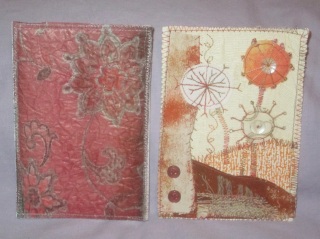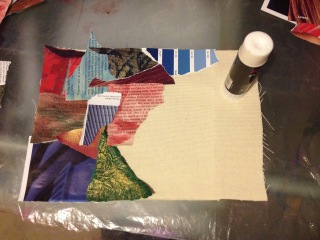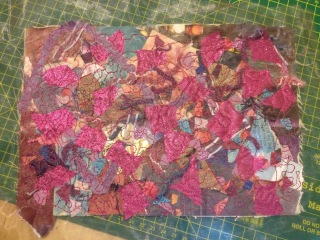 |
| My first experimental piece |
This was where we were at the end of my last post. I had finished stitching my first experimental piece of fabric. The next stage was to blast it with my heat gun to burn back some of the fibres.
 |
| First experimental piece after blasting with a heat gun |
I was very disappointed with the results after I had blasted it with the heat gun. Hardly any of the fabric had been burnt back. My theory is that the lack of burn back was due to the closeness of the stippled stitching: I think there was insufficient room for the heat to build up and/or for the fabric to burn back. In view of that theory, I began work on my second and third attempts.
As with my first play session, I laid a background of papers and topped it with a layer of fabric scraps, ribbon and so on. I lay a piece of organza across the prepared piece and trotted down to the sewing machine. I did just enough free motion stitching to ensure all loose pieces were lightly caught.
 |
| Second piece after being lightly stitched |
I blasted the stitched piece with the heat gun. This time the fabric burned back more successfully, which seemed to confirm my theory about the heavy stitching preventing burn back on my first piece.
 |
| Result of burning back the second experimental piece |
Although I was happy with the result of the heating process, the piece of fabric lacked any ‘body’ or stiffness. Accordingly, I lay more papers, fabrics and bits and pieces across it. One ingredient I have omitted to tell you I have used throughout this entire playtime was scraps of painted Tyvek fabric, some of which I included at this stage.
 |
| During preparation of the second stage of the second piece |
At this stage, I dug out some sparkly gold cord [or yarn, I’m not sure exactly what it is!] and threw some chopped up lengths on the piece. When I was happy with how it looked, I placed a piece of organza over it and secured it in place. Woohoo! After having struggled carefully between my craft room and my sewing machine several times, I had a brainwave! Humungous paperclips!
 |
| Can you see the huge paperclips around the edges? |
Is this girl brilliant? Or is this girl brilliant? The huge paperclips work a treat! They held the edges together along their entire length of 7 cm, so they really were ultra-useful. Also, I was able to stitch fairly close to them which meant I wasn’t struggling to keep all the bits and pieces in place. I kept the stitching to a minimum on this layer, also, because of wanting to be able to burn fibres back.
 |
| My second piece after being blasted by the heat gun |
This is how the second piece looks after stitching and burning back. It has a very different appearance and character to my first experimental piece.
 |
| Detail showing result of light stitching and heating |
 |
| An edge of the second piece showing successful burning back of fabric |
 |
| Results of second and third experimental pieces |
 |
| Details of corners of second and third pieces |









